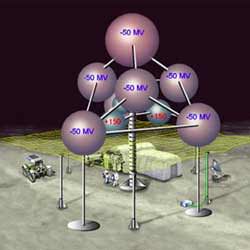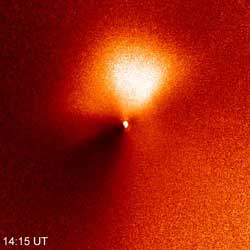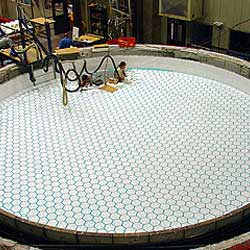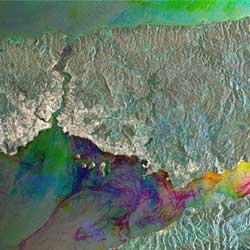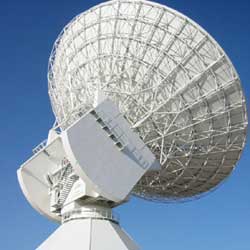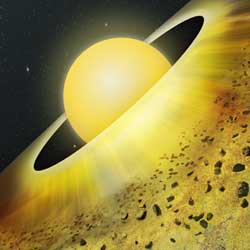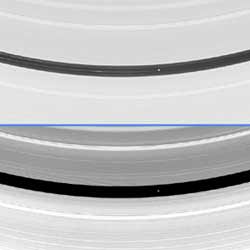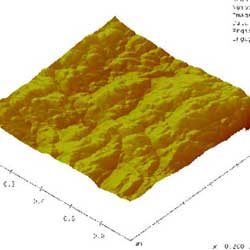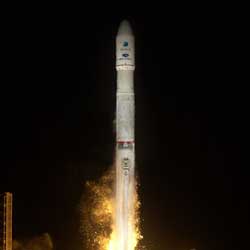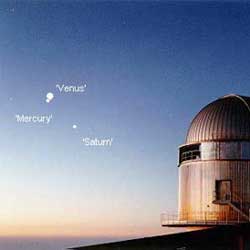
Visualization of skies on June 27. Nordic Optical Telescope. Image credit: Jacob Clasen. Click to enlarge.
Monday, June 27 – You asked for something cool? You got it. Tonight Venus and Mercury will be so close to each other for American viewers that their apparent separation will depend mainly on your viewing position. Known as an appulse, viewers in the east will catch the pair around 7 arcminutes apart – that’s just a fraction over one-tenth of a degree! In the west, the separation will be nearer 9 arcminutes, and if you observe in Hawaii? 10 arcminutes. Be sure to take the opportunity to see the very closest planetary pairing of the year! Wishing you all clear skies…
Be on the lookout tonight for a handful of meteors originating near the constellation of Corvus. The Corvid meteor shower is not well documented, but you might spot as many as ten per hour.
Tuesday, June 28 – Our splendid sunset dance of the planets continues as tonight Mercury has shuttled less than half a degree to the left of Venus and Saturn has slid to the lower right of our close pairing as they continue to rise. Still in range of most binocular fields, Venus and Saturn have now separated by about three and half degrees.
With the time of Deep Impact growing closer by the hour, I am not going to leave you alone until you locate this comet for yourself! Rapidly approaching perihelion, 9/P Tempel 1 is roughly the same brightness as the “Ring” nebula – so what are you waiting for? About a degree and a half northeast of Spica, you can easily spot star 76 in binoculars or finderscope, and the comet is just to its west. Once you locate it, it will be easy to follow as it continues slowly due south. Don’t wait until the last minute to view this comet, because as all astronomers know – you don’t make a “date” with the sky, it makes one with you!
Wednesday, June 29 – Are you enjoying the intriguing show of the planets? Then get up early to catch Mars and the Moon roughly four degrees apart! Watch the planets again after sunset as speedy Mercury continues to distance itself from Venus. They will appear slightly more than half a degree apart. What we are witnessing is Mercury turning around in its orbit and it’s just luck that it happens to be near Venus from our viewpoint.
Today we celebrate the birthday of George Ellery Hale, who was born in 1868. Hale was the founding father of the Mt. Wilson Observatory. Although he had no education beyond his baccalaureate in physics, he became the leading astronomer of his day. He invented the spectroheliograph, coined the word astrophysics and founded the Astrophysical Journal as well as Yerkes Observatory. At the time, Mt. Wilson dominated the world of astronomy, confirming what galaxies were and verifying the expanding universe cosmology, making Mt. Wilson one of the most productive facilities ever built. When Hale went on to found Palomar Observatory, the 5-meter (200″) telescope was named for him and dedicated on June 3, 1948. It continues to be the largest telescope in the continental United States.
Let’s celebrate Hale’s achievements tonight by viewing a pair of interacting galaxies. 40′ northwest of Beta Canum Venaticorum is NGC 4490 and smaller, fainter companion NGC 4485. This pair, also known as Arp 269, are quite unusual in appearance to the larger scope. NGC 4490 is around magnitude 10 and shows a bright, irregular core region and a rather strange profile. Known as the “Cocoon” galaxy, it appears to almost reach toward its companion 3′ to the north. Progressively larger scopes under ideal conditions will be able to make out some faint mottling in the NGC 4490’s structure.
Thursday, June 30 – And the show goes on. Mercury and Venus are separated by close to one degree tonight, and this is getting to be your last chance to catch Saturn before it quickly blends in with the twilight glow.
With the Moon comfortably out of the way, tonight would be an excellent opportunity to just find a comfortable seat, relax and watch for the June Draconid meteor shower. The radiant for this shower will be near handle of Big Dipper – Ursa Major. The fall rate varies from 10 to 100 per hour, but tonight’s darker skies will offer us a better than usual chance to spot the offspring of comet Pons-Winnecke. On a curious note, today in 1908 was when the great Tunguska impact happened in Siberia. A fragment of a comet, perhaps?
Friday, July 1 – Tonight we honor southern skies by exploring the fantastic, NGC 3372 – the Eta Carinae Nebula. As a giant, diffuse nebula with a visual brightness of magnitude 1, (wow!) it contains the most massive and luminous star in our Milky Way galaxy, Eta Carinae. It’s also home to a small cluster, Collinder 228, which is only one of 8 cataloged open clusters within the area of this huge star-forming region; the others are Bochum (Bo) 10, Trumpler (Tr) 14 (also cataloged as Cr 230), Tr 15 (= Cr 231), Cr 232, Tr 16 (= Cr 233), Cr 234, and Bo 11. Star Eta Carinae is involved in open cluster Trumpler 16. This fantastic nebula contains details which northerners can only dream about, such as the dark “Keyhole” and the “Homunkulus” around the giant star itself. A fantastic region for exploration with both telescopes and binoculars!
Saturday, July 2 – For west, central, and southern Europe, the Moon will occult Delta Aries for you on this universal date. Please check this IOTA webpage for more details on times in your area. For our southern hemisphere friends, tonight will be very busy. Starting with New Zealand, the Moon will occult 4th magnitude 23 Tauri, 3rd magnitude Alcyone, and head towards southeast and central Australia for 27 Tauri all on this same universal date.
Today marks the 20th anniversary of the comet Halley mission – Giotto – launch. Comets are going to be very much in the news over the next few days and if you have not taken the time to look for Deep Impact’s target, Tempel 1, let’s try again tonight. Just marginally due east (about a degree and a half) of bright Spica, our comet should have brightened to magnitude 9 by this time – putting it well within the capabilities of small scopes and large binoculars. Larger telescopes will easily note a bright, almost stellar nucleus and broad fan of tail. Tempel 1 will continue southward, passing almost mid-way between Gamma Virginis and star 68 by tomorrow night. Don’t miss this opportunity!
Sunday, July 3 – Time is up. Today is the scheduled time for the Deep Impact mission to release the impactor. The clock is ticking and if you still haven’t located 9/P Tempel 1, try again tonight! There are no deep sky objects even remotely close to Tempel 1’s brightness in the area between Gamma and star 68 Virginis. Even if you have only modest binoculars, please check out the field. Place blue/white Spica, (the brightest star near Jupiter) just to the right of the field of view and you will see two visible orangish stars equidistant toward the left. It is between (and slightly below) these two stars that Deep Impact will occur and there is a strong possibility that it will flare brightly enough over the next couple of days to reach near unaided visibility. If you live in a light polluted area, it would be quite worth the drive to a darker location the keep track of this event. It’s out there… And it’s only about 400 light seconds away!
Wishing you all clear skies! May all your journeys be at Light Speed… ~Tammy Plotner

